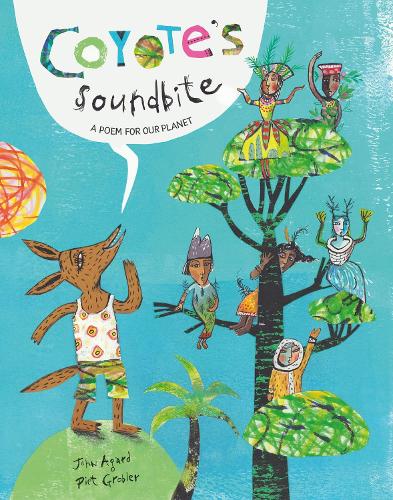Review: Coyote's Soundbite: A Poem for Our Planet by John Agard, illustrated by Piet Grobler
Meanwhile, not one to miss the action, anthropomorphised Mr Coyote hatches a cunning plan to infiltrate the exclusive meeting covertly and deliver his 'soundbite'. But will his cover be blown, and can the Earth be saved?
Recent world events have accentuated, more than ever, the need to take care of our planet, and this distinctive narrative poem by John Agard — a sort of myth-and-fable mash-up — is a stimulus for discussing environmental concerns with children in upper KS2.
Written in lyrical three-line stanzas with rich imagery and inventive sentence construction, Agard wrote the piece in tribute to Earth Day, observed globally each year to raise awareness of environmental issues.
The key characters, described in turn, are loosely based on deities from various traditional creation stories, from Aboriginal Dreamtime to Irish mythology, which is a really fascinating aspect of the text.
For example, Oduduwa is believed to have been a Yoruba divine king (Agard has changed his gender for the purposes of the story) and one of the creators of the Earth; Kujum Chantu, from North-East India, was originally the Earth itself (early humans, indeed, were supposed to have lived on her large belly); and Brigid was the Irish pre-Christian goddess of spring and fertility among other things. Agard uses flowery metaphors to describe these observant goddesses and their innate oneness with nature. They speak eloquently about the disastrous consequences of industrial capitalism on the earth's delicate ecosystems.
Piet Grobler's quirky, highly intricate mixed-media illustrations are whimsical and engaging, supporting the poetic text wonderfully. Each scene is full of endearing animals and luscious greenery of infinite variety, tempered by natural earthy pigments in keeping with the ecological and cultural themes. Lovely observational details highlight modernity's clash with nature. For example, the thoughtful Earth goddesses travel to the conference on foot or by animal, passing dreary carbon-emitting factories, aeroplanes, and helicopters. Grobler's use of a tree as an organic wardrobe for Mrs Coyote's dresses is another lovely imaginative touch.
During shared reading of the text for Earth Day, children could pick out words/lines supporting the idea that humans are damaging the environment, and they could discuss the consequences of these actions. You may need to support children to unpack the more challenging lines as the text is written in a quaint oral storytelling style that would benefit from being read several times aloud. They might like to prepare and film their own Earth Day debate, afterwards thinking of practical ways to look after their local/school environment. While re-watching film clips of their debate, they could select powerful soundbites that would persuade the rest of the school to consider environmental issues (computing/PSHCE).
I did wonder whether the progressive message of female empowerment was diminished by 'clever' Mr Coyote's cross-dressing and mansplaining — though the surprise ending slightly offsets this. I would also have liked Oduduwa to reveal more about specific environmental issues in Africa.
That said, this is an unconventional, entertaining poem which, although amusing at times, will encourage children to think seriously about other cultures and environmental issues. It's a 21st-century moral lesson on being responsible, caring, and more in tune with the natural world.
Coyote's Soundbite: A Poem for Our Planet will be available in hardback from Bookshop on Earth Day 22 April.
Thanks to Lantana Publishing for the review copy of the book.
Resources
Earth Day website. Earth Day is observed around the world on 22 April every year. Earth Day was first celebrated in 1970, and this momentous event is now seen as the start of the modern environmental movement.
Guide for teachers and parents
Genre | Poetry: Narrative poem |
Child-led interests (EYFS) | N/A |
Age group (EYFS, KS1, KS2) | KS2 upper (Y4 upwards) |
Curriculum links/topics (EYFS/NC) | English: Speaking and listening (Y1-6):
Computing (KS2):
PSHCE: environmental awareness; taking care of your environment; community; building self-esteem |
Suitability | whole-class teaching, storytime, class/school library, home library |
General features | non-rhyming three-line stanzas; rich imagery: metaphor, eg, her eyes grew into the sun and moon; similes, eg, news spread like bushfire; adjectival phrases, eg, bushy-tailed, smooth-talking coyote, sun-blessed light of spring, high-class lady; some rhyme; sound effects: alliteration, eg, coming conference, big burning, soft spiralling; some repetition; unfamiliar vocab: permafrost, conference, calabash, kola nut, soundbite; occasional dropping of plural inflection '-s'; includes some more archaic-style language including kennings, eg, globe-trotter, iceberg-rider |
All the Black children's books that I review are checked against my Jericho Benchmark.



Comments
Post a Comment